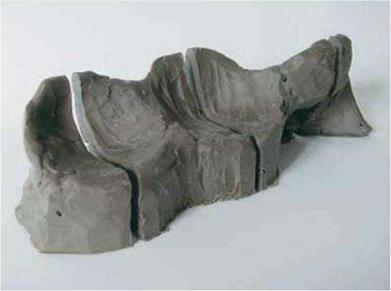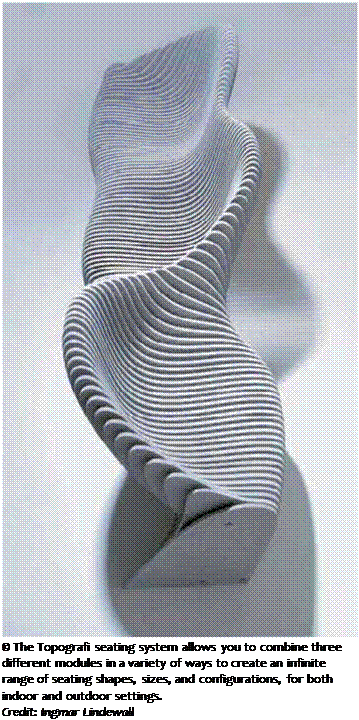 “I wanted to make something of an organic shape so it would feel soft to your body, but is not upholstered. It is hard, but shaped around your body so it feels soft when you sit in it.”
“I wanted to make something of an organic shape so it would feel soft to your body, but is not upholstered. It is hard, but shaped around your body so it feels soft when you sit in it.”
The result of this original concept was an easy chair made while still in design school. The hard part of the chair was made of painted MDF (medium density fiberboard), between which Wannfors sandwiched pieces of felt. “The felt stood up a little bit, so that’s what you sat on,” he notes. He made this prototype himself, working with a metal manufacturer. “At first,” he says, “they couldn’t understand how it would turn into a seat from the drawings. But afterwards, they were excited.” This prototype was displayed at a graduation exhibition as well as at the Stockholm International Furniture Fair. “After that school project, I wanted to see if I could use that idea for more complex furniture, for more intelligent furniture,” he continues. “I wanted to create this system that would let you create your own seating.”
The result of this effort is the Topografi modular seating system, manufactured by LYX. Three different modules can be combined in a wide variety of configurations to create anything from a single chair to a sinuous sofa of two-sided seating that goes on and on for as long as space allows. The system comes in indoor and outdoor versions made from thirty-four slices of water-cut and painted MDF or fiber concrete board. Each slice is separated by spacers and connected with a metal tube. To create a seat, you always need two end modules, but you can put endless straight or exchange sections in between. The modules are connected to one another with a small bolt. “It looks very uncomfortable because of all the slices,” notes Wannfors. “The basic idea is that it looks very hard, more like a sculpture than seating, but when you sit in it, it feels very good and very relaxing.”
For the Topografi, like most of his design projects, Wannfors began with a hand sketch. “I get an idea in my head,” he says, “and I use the paper to get it down. Many times, only I can understand the sketches that I made.” From there, he moves to clay models. “I do modeling in clay because it’s impossible to understand everything with just the sketches. Many times it’s difficult to see if things work three dimensionally just with sketching.” He always includes computer modeling at the end of the process. “There are many benefits from it,” Wannfors notes. “You can create presentation materials and advertising materials. And if you make a good computer sketch, it saves time later on. But I never start to sketch on the computer.”
In the case of the Topografi, the computer was also used to work with human models to get the curves and the proportions just right. Wannofors notes, “We used full-scale models to check the seating curve and the profile for your back support.” In addition to these practical considerations, the sensuous curves were created to serve aesthetic and design concerns as well. “I wanted to
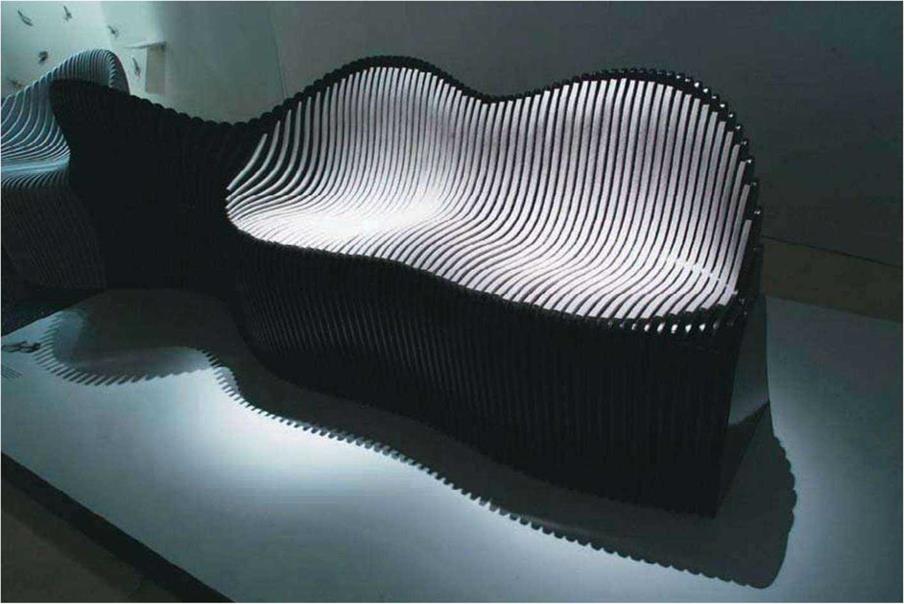
|
|
(л) Top: The first prototype of what would become the Topografi was made as a school project out of concrete boards separated by industrial felt to create a seat of both hard and soft elements. Credit: jonos Wannfors
C j Because of the complexity and variety of the shapes, clay modeling was essential to understanding how the component parts might work separately and together. Credit: Jonas Wannfors
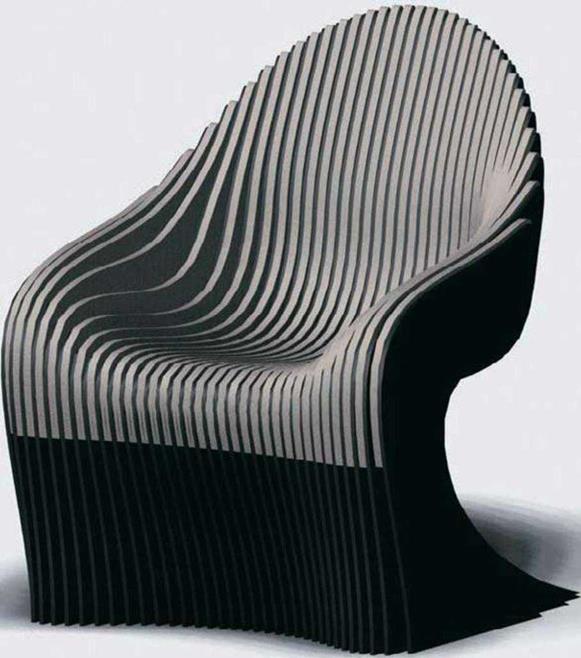 ® Working off the idea of “creating a 3D object by using two-dimensional sheets,” this computer rendering depicts the initial concept that eventually evolved into the Topografi system. Credit: Jonas Wannfors
® Working off the idea of “creating a 3D object by using two-dimensional sheets,” this computer rendering depicts the initial concept that eventually evolved into the Topografi system. Credit: Jonas Wannfors
create a really organic shape,” Wannafors says, “that was as smooth as possible to be in contradiction with the different slices or the boards themselves that are square at the beginning. From these pieces, you cut shapes and create something very different from what you had in the beginning.”
As a young designer, moving from his original concept to a commercially produced product offered Wannfors many lessons that even highly experienced designers find themselves relearning. “For a long time,” he notes, “I wanted to keep the felt between the sheets. But along the way, I discovered that the felt pieces didn’t do anything for the seating. And it was impossible to put it there, you couldn’t take it away to wash it, and it was expensive.” Repeating a piece of literary advice usually attributed to Ernest Hemingway, Wannfors says he had to “kill my darlings.” Other concessions were made to practicality. “In the first prototype, I had a little different spacing, and then we adjusted it to make it more economical to produce. A little less material, a little more air,” he notes. “The most surprising thing for me was that the things I didn’t think would cost anything were the things that cost the most, and the things I thought would be expensive cost nothing.” And Wannfors learned how long things really take to go from idea to reality. “When you’re in school you think, ‘Oh I made a prototype, it’s completed.’ But that’s only a small part of it. You have to stay focused, you have to be there and watch everything so it turns out good in the end. You can’t just turn it over to the manufacturer.”
But some important efficiencies also came out of the process. “I thought that to create this modular seating, you make one seat and then another and something to put them together,” Wannafors says. But in manufacturing, they found only four components would make a multitude of seating forms. “This was a good discovery,” he notes. “I could make less pieces to make the whole system.”
The Topografi can be seen as a kind of bridge that took Wannafors from his life as a design student to that of a design professional who now works in graphics, lighting, and furniture. Looking back on the process, he says, “Still, after all this time, I’m amazed at all the work, and I’m very satisfied with the result. Sometimes, you make something, and after five years, you think, ‘Oh, that’s not very good,’ but this still feels fresh even though I’ve lived with it for a long time.”

 The Topografi also reminds him of an episode in his life when he had the freedom to be entirely focused on ideas. “When I look at this piece, it reminds me that when you’re in school, you have so much time to develop things,” he reflects. “And now, it’s hard to get the time to just think and be creative and not go to meetings all the time,” he adds with a good-natured laugh.
The Topografi also reminds him of an episode in his life when he had the freedom to be entirely focused on ideas. “When I look at this piece, it reminds me that when you’re in school, you have so much time to develop things,” he reflects. “And now, it’s hard to get the time to just think and be creative and not go to meetings all the time,” he adds with a good-natured laugh.

0 A computer rendering shows the three modules— straight, exchange, and end—that can be connected in any combination to create a customized seating arrangement. Credit: Jonas Wannfors
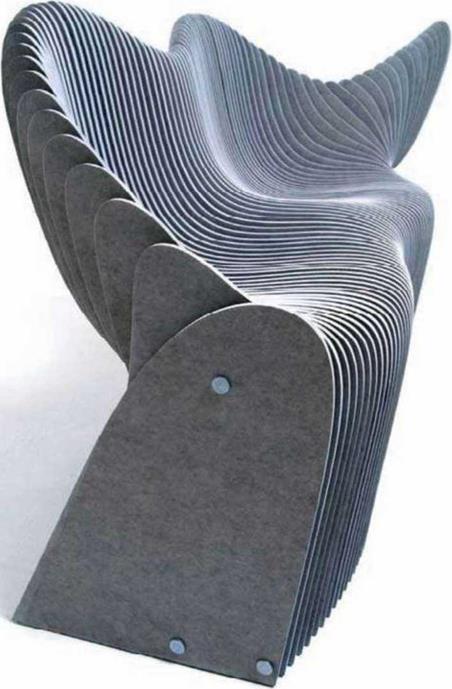
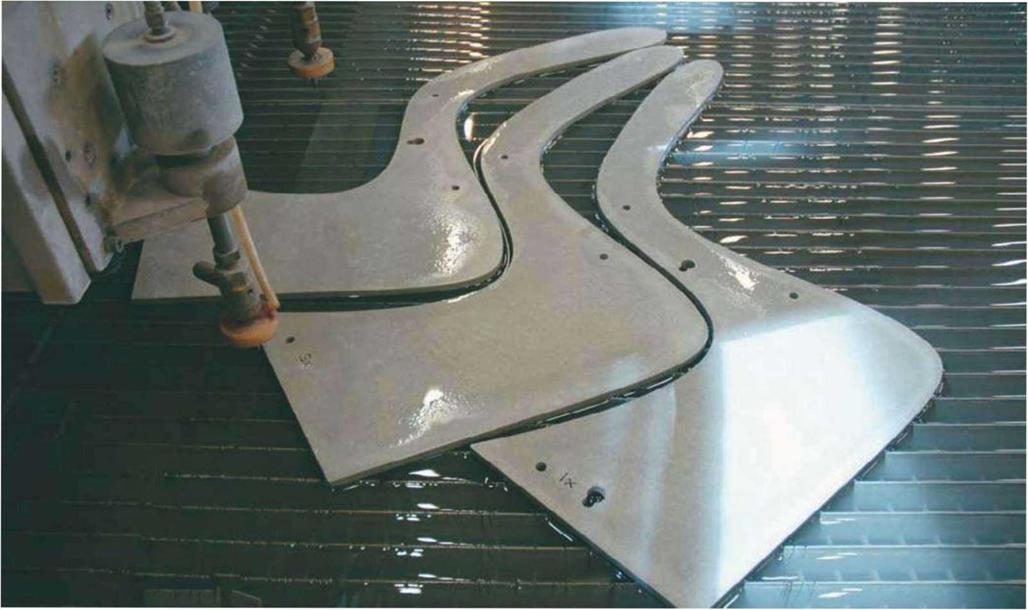
(л) The concrete and fiberboard pieces are cut with a water jet. By placing the shapes like a jigsaw puzzle, they reduce manufacturing waste.
Credit: Jonas Wannfors
© This Topografi configuration is made into a sinuous sofa with straight, exchange, and end modules of concrete fiberboard. The components are also available in thermocoated MDF (or medium density fiberboard). Credit: Ingmar Lindewall

